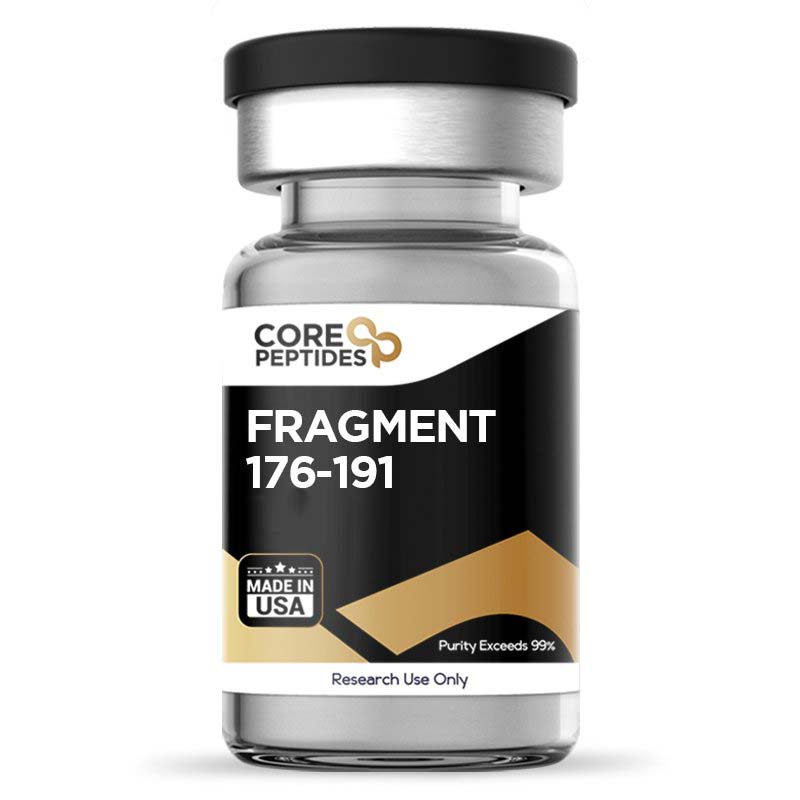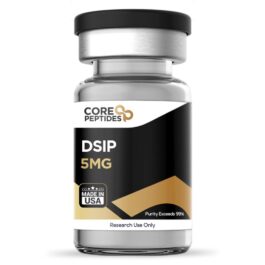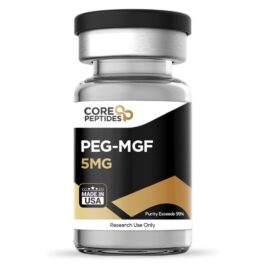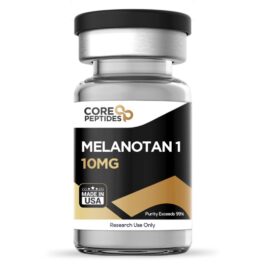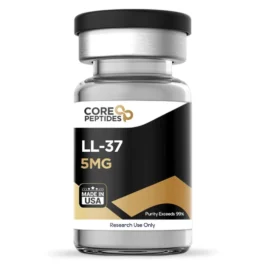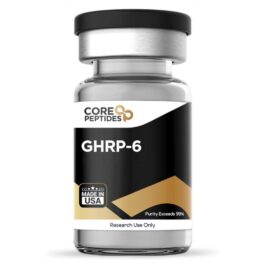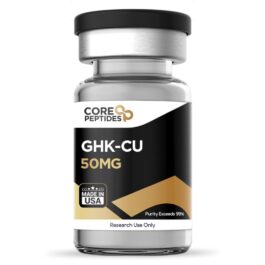Fragment 176-191 (5mg / 10mg)
Price range: $44.00 through $72.00
Size: 5mg / 10mg
Contents: Fragment 176-191
Form: Lyophilized powder
Purity: >99%
SKU: P-FRAG176-191
FREE Shipping on $200+ orders
Discount per Quantity
| Quantity | Discount | Price |
|---|---|---|
| 5 - 8 | 5% | Price range: $41.80 through $68.40 |
| 9 + | 10% | Price range: $39.60 through $64.80 |
Fragment 176-191 Peptide
Fragment 176-191 peptide, also known as hGH Fragment 176-191, tyr-hGH 177-191, or AOD-9604, has been suggested by researchers that it may stimulate weight loss and fat burn in a fashion similar to that of the growth hormone (hGH). hGH is a naturally occurring hormone, which, apart from stimulating growth, as the name suggests, may also stimulate catabolism of adipose tissue and the release of lipids from fat cells. Fragment 176-191 is a small ‘fragment’ of the growth hormone hGH composed of 16 amino acids. This involves the last 16 amino acids of the hGH molecule, which scientists propose to be the “lipolytic fragment” of hGH. Lipolythic, as a term, reflects the purported fat-burning properties of the molecule. To potentially improve the stability of the peptide, the first amino acid in the hGH Fragment 176-191 sequence is also replaced by tyrosine. Thus, the peptide is also labeled as Fragment tyr-hGH 177-191.(1)(2)
Overview
This peptide could, in theory, aim at the beta-3 adrenergic receptors (ß3-AR), which might, in turn, lead to a potential weight loss action. It is posited that through these receptors, the peptide may encourage fat burning in adipose tissue and foster 'thermogenesis' in skeletal muscle cells. In a study involving obese murine models exposed to the peptide for two weeks, there seemed to be an apparent decrease in weight, including a reduction in excess fat. These observations are thought to be linked to a rise in the activity of lipolytic beta-3 adrenergic receptors, hinting that the peptide's actions could be connected to the beta-adrenergic pathway. The researchers commented that Fragment 176-191 may be “capable of increasing the repressed levels of beta(3)-AR RNA in obese mice to levels comparable with those in lean mice.” Unfortunately, the data may not be conclusive, as the research on murine models with disabled lipolytic receptors suggested that the peptide still led to apparent weight loss, suggesting its actions might not solely rely on these receptors. Thus, it was also considered that the peptide might help burn fat through mechanisms like energy expenditure and fat oxidation, though this remains an area for further investigation.(3)
As mentioned, the presence of tyrosine at the N-terminus of the fragment increases the stability of the peptide. In addition, there appears to be a naturally occurring disulfide bridge between the two cysteine amino acids in the molecule of hGH and hGH Fragment 176-191. This bridge appears to further stabilize the molecule and may increase its resistance against degradation in various environments, including stomach acid.(4)(5)
Chemical Makeup
Molecular Formula: C78H125N23O23S2
Molecular Weight: 1817.12 g/mol
Other Known Titles: hGH Fragment 176-191; Lipolytic fragment
Research and Clinical Studies
Fragment 176-191 and Fat Cells
As mentioned, Fragment 176-191 is believed to potentially increase fat burning through different mechanisms, which may include the upregulation of the beta-3 adrenergic receptors. More specifically, the peptide might elevate the expression levels of beta(3)-AR RNA in fat cells. This suggests that Fragment 176-191 may influence signaling pathways or transcription factors that enhance the production of beta-3 adrenergic receptor mRNA, leading to increased synthesis of the beta-3 adrenergic receptors protein. With more beta-3 adrenergic receptors present on the surface of adipocytes (fat cells), the cells may become more sensitive to lipolytic signals. This posits that even though Fragment 176-191 may not directly activate beta-3 adrenergic receptors, the increased number of receptors might amplify the natural lipolytic response to endogenous catecholamines (like adrenaline), which are suggested to engage these receptors directly. Fragment 176-191 might also activate other cellular signaling mechanisms that indirectly boost fat burning. For example, it may influence pathways that either upregulate the expression of enzymes involved in the lipolysis process or enhance the cellular response to lipolytic signals by modulating the activity of secondary messengers within the cell.
This has been explored by clinical trials, the most notable of which was METAOD005. This trial was initiated to explore the possible fat-burning action of a peptide. 300 test subjects were involved in this investigation, which lasted 12 weeks. There were six groups, including one control group and five Fragment 176-191 groups. It was suggested that one of the Fragment 176-191 groups experienced an apparent decrease in body weight, potentially by around 5.7 pounds. Moreover, it was posited that the peptide may have possibly contributed to improvements in the cholesterol levels and glucose tolerance of these participants.(6)
Fragment 176-191 and Cartilage Regeneration
Some researchers have posited that Fragment 176-191 peptide may have some of the proposed regenerative properties of hGH, in addition to its apparent fat-burning potential. To explore these potential impacts of Fragment 176-191 peptide, researchers used a knee osteoarthritis model caused by collagenase. The experimental models were introduced with type II collagenase to apparently induce damage to the knee cartilage. Following this, for a period of 4-7 weeks, the models were split into four groups including saline (Group 1), hyaluronic acid (Group 2), Fragment 176-191 peptide (Group 3), and a combination of Fragment 176-191 peptide with hyaluronic acid (Group 4). The severity of the cartilage damage was evaluated through both morphological and histopathological analysis, and the degree of lameness was observed 8 weeks after the beginning of the trial. The researchers commented, "Mean gross morphological and histopathological scores were significantly higher in Group 1 than in Groups 2, 3, and 4, and the scores were significantly lower in Group 4 than in Groups 2 and 3. The lameness period in Group 4 was significantly shorter than those in Groups 1, 2, and 3.” This suggested that both hyaluronic acid and Fragment 176-191 peptide may be better than saline in stimulating an apparent cartilage regeneration, and the best research outcome may be achieved with a combination of Fragment 176-191 peptide and hyaluronic acid.(7)
Fragment 176-191 and Hyperglycemia
In one study,(8) several synthetic hGH peptides, including Fragment 176-191, were presented in normal functioning murine models to determine its potential on glycogen metabolism. Upon delivery, it was reported that the peptide appeared to induce a slight increment in levels of blood glucose and lactate, with a slight reduction in the ratio of glycogen synthase in muscle, adipose tissues, and the liver. It was suggested that this outcome was due to the peptide's apparent action of converting the enzymes from their active state to inactive state, as the total synthase levels appeared to remain at constant concentrations.
Fragment 176-191 peptide is available for research and laboratory purposes only. Please review and adhere to our Terms and Conditions before ordering.
References:
- Cox HD, Smeal SJ, Hughes CM, Cox JE, Eichner D. Detection and in vitro metabolism of AOD9604. Drug Test Anal. 2015 Jan;7(1):31-8. doi: 10.1002/dta.1715. Epub 2014 Sep 10. PMID: 25208511.
- Heffernan, Mark, et al. "The Effects of Human GH and Its Lipolytic Fragment (AOD9604) on Lipid Metabolism Following Chronic Treatment in Obese Mice andβ 3-AR Knock-Out Mice." Endocrinology 142.12 (2001): 5182-5189.
- Heffernan M, Summers RJ, Thorburn A, Ogru E, Gianello R, Jiang WJ, Ng FM. The effects of human GH and its lipolytic fragment (AOD9604) on lipid metabolism following chronic treatment in obese mice and beta(3)-AR knock-out mice. Endocrinology. 2001 Dec;142(12):5182-9. doi: 10.1210/endo.142.12.8522. PMID: 11713213.
- Stier, Heike, Evert Vos, and David Kenley. "Safety and Tolerability of the Hexadecapeptide AOD9604 in Humans." Journal of Endocrinology and Metabolism 3.1-2 (2013): 7-15.
- Moré, Margret I., and David Kenley. "Safety and metabolism of AOD9604, a novel nutraceutical ingredient for improved metabolic health." Journal of Endocrinology and Metabolism 4.3 (2014): 64-77.
- Valentino, M A et al. “Central and peripheral molecular targets for antiobesity pharmacotherapy.” Clinical pharmacology and therapeutics vol. 87,6 (2010): 652-62. doi: 10.1038/clpt.2010.57
- Kwon, Dong Rak, and Gi Young Park. “Effect of Intra-articular Injection of AOD9604 with or without Hyaluronic Acid in Rabbit Osteoarthritis Model.” Annals of clinical and laboratory science vol. 45,4 (2015): 426-32.
- Ma GY, Macaulay SL, Maggs JA, Armstrong JM, Bornstein J. The mechanism of the hyperglycaemic action of synthetic peptides related to the C-terminal sequence of human growth hormone. Biochim Biophys Acta. 1982 Jun 16;716(3):400-9. doi: 10.1016/0304-4165(82)90033-2. PMID: 6810951.
